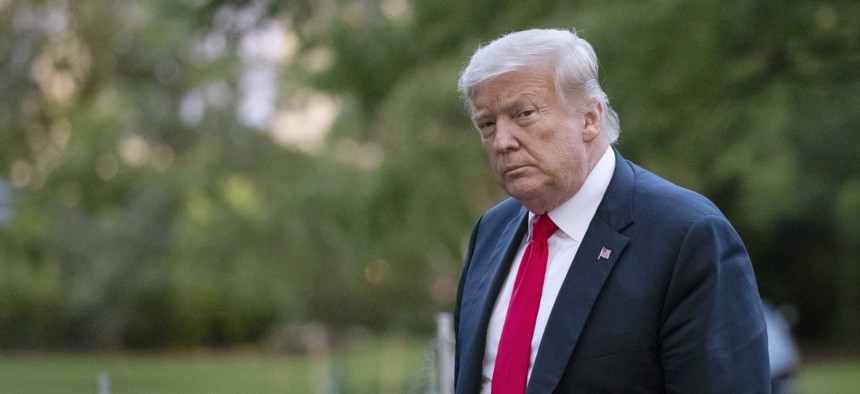
President Donald Trump walks on the South Lawn after arriving on Marine One at the White House in Washington. The president's brother Robert Trump has filed a second court action seeking to halt publication of a tell-all book by the president's niece. AP Photo/Alex Brandon
Political Fight Over Russian Bounty on US Troops Appears to Warp Intel Debate
Democrats suspect the White House is trying to paint the assessment as less solid than it is.
A battle is raging between the White House and Democrats over intelligence revealing Russian-offered bounties on U.S. troops in Afghanistan that appears to reflect a funhouse mirror version of an arcane internal debate over the reliability of the assessment.
The unusually public fight over what are known in the intelligence field as “confidence levels” — typically the subject of behind-the-scenes deliberation between three-letter agencies — has turned into front-page news and social media speculation, as the White House seeks to defend itself against charges that President Donald Trump ignored credible reports of the bounty program for months.
House Republicans briefed on the intelligence Monday afternoon at the White House slammed the information, first reported in the New York Times, as “weak” and “unconfirmed.” Rep. Mike McCaul, R-Texas, ranking member on the House Foreign Affairs Committee, said in an interview with NBC News that the president wasn’t briefed on the information because it was “not at that point in time a credible, actionable piece of intelligence.”
But after a separate Tuesday morning briefing at the White House for House Democrats, lawmakers characterized the intelligence as solid enough to have warranted further investigation, at minimum.
“There is conflicting intelligence in terms of exactly what happened here,” House Armed Services Committee Chairman Adam Smith, D-Wash. told reporters shortly after the briefing. “I think there was certainly enough there to pursue it further and and I think there was enough there for it to factor into the relationship with Putin and Russia — to have it be a topic of concern.”
“I have not yet seen enough to tell me if the Trump administration responded in an appropriate way to this initial intelligence,” Smith said. “I am concerned they didn't pursue it as aggressively or as comprehensively as they should have."
U.S. intelligence pointing to the Russian bounty program reportedly was based at least in part on interrogations of human sources — a notoriously trickier form of intelligence to vet and verify than information gleaned from intercepted communications. McCaul, in a separate interview with NPR, said “one of the three-letter agencies” registered a strong dissent as to the strength of the assessment of the bounty program. Another “believed there was strong evidence.”
This kind of debate within or among intelligence agencies isn’t unusual. Intelligence assessments often piece together evidence from different sources, and there can be disagreement about what it all adds up to mean. Sometimes the disagreement is substantive; other times, it’s institutional. Intelligence analysts rate the certainty of a given assessment as “high confidence” or “low confidence.”
The New York Times and the Wall Street Journal have reported that the dispute over the bounty assessment arose between the National Security Agency, which specializes in signals intelligence, and the CIA, which is more focused on human intelligence. In this case, the CIA was more certain of the conclusion. Those two agencies have come to differing conclusions on related issues before. In the 2017 intelligence community assessment that Russia had attacked the 2016 U.S. election process, the NSA had only “moderate confidence” that Trump was Putin’s preferred candidate, while the CIA had “high confidence.”
In that case, a post-action review by the Senate Intelligence Committee found that “the analytic disagreement was reasonable, transparent, and openly debated among the agencies and analysts, with analysts, managers, and agency heads on both sides of the confidence level reasonably justifying their positions.”
By Tuesday afternoon, reporting from the New York Times suggested that the disagreement over confidence in the Russian bounties assessment might have already been resolved before the White House briefings this week. Analysts intercepted electronic data between a bank account controlled by Russian military intelligence and a Taliban-linked account, bolstering the conclusion about the bounty program, supporting findings from the interrogations of Taliban-linked detainees, and “helping reduce an earlier disagreement among intelligence analysts and agencies over the reliability of the detainees,” the Times reported.
The White House did not share those findings with lawmakers this week — raising questions about whether Trump administration officials sought to overplay the earlier disagreement inside U.S. intelligence community in an effort to paint their assessment about the bounties as less conclusive than it was, according to one Democratic lawmaker who spoke to Defense One on the condition of anonymity.
Democrats have complained that the briefing was mainly done by White House and National Security Council officials — not intelligence community officials. CIA Director Gina Haspel and NSA Director Gen. Paul Nakasone were not in the briefing.
“The right people were not in the room to give us the kind of briefing that we needed to get,” Rep. House Intelligence Committee Chairman Rep. Adam Schiff, D-Calif., chairman of the House Intelligence Committee, said in a press conference after leaving the White House briefing Tuesday morning.
Haspel has kept her low public profile throughout the uproar over the alleged bounty program, issuing an anodyne statement Monday night saying that “initial tactical reports often require additional collection and validation.”
“In general, preliminary Force Protection information is shared throughout the national security community—and with U.S. allies—as part of our ongoing efforts to ensure the safety of coalition forces overseas,” she said.
Some Republicans are pressing for more information.
"After today's briefing with senior White House officials, we remain concerned about Russian activity in Afghanistan, including reports that they have targeted U.S. forces,” said Rep. Mac Thornberry, R-Texas, the top Republican on the House Armed Services Committee, who is retiring, and Rep. Liz Cheney, R-Wyo., also a committee member.
Part of the debate may turn on whether or not any Americans were killed as a result of the alleged bounty program. Lawmakers who have been briefed on or reviewed the intelligence give conflicting accounts. GOP lawmakers briefed by the White House were told that no Americans were killed. But both the Times and the Post have reported that intelligence officials believe the deaths of at least one and possibly as many as “several” service members are linked to the bounty program. And some lawmakers have appeared to suggest that they have seen intelligence to suggest that.
“I just reviewed the intel. It’s not a hoax, Mr. President,” tweeted Sen. Chris Murphy, D-Conn. “And if you continue ignoring the facts, more soldiers and marines are going to die.”
Former intelligence officials say it would be extremely difficult to prove conclusively that an American was killed as a direct result of the program, since the United States was already at war with the Taliban. How would the U.S. prove that an attack would not have happened if it weren’t for the incentive of the bounty, asked one former senior intelligence official recently returned from service in the region.
“I would say, let’s go back and look at those [22] service members'' who were killed during 2019, that person said. “Do we think it would be 18, 19, 17, if Russia hadn’t done this thing? How do you prove that the American citizen wouldn’t have been killed?”
Under particular scrutiny is an April 2019 bombing near Bagram Air Base that killed three Marines. Twenty-two U.S. troops were killed in Afghanistan last year, including some who were killed in insider attacks by Afghan security forces that the United States is supporting and suspects are sometimes infiltrated by the Taliban.
The Defense Department and the NSC did not respond to a request for comment on whether there was a link between the bounty program and the deaths of any U.S. service members in 2019.




